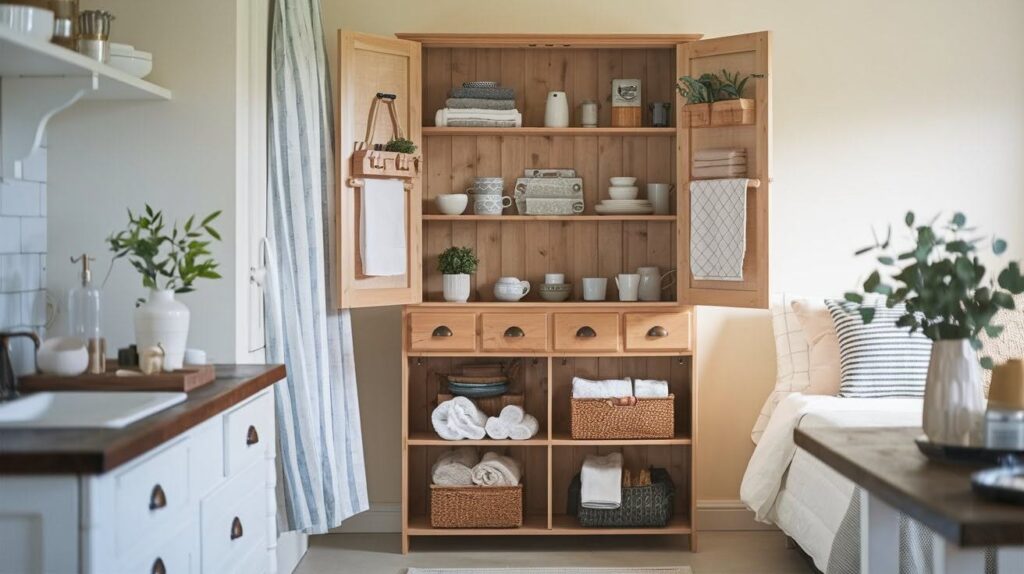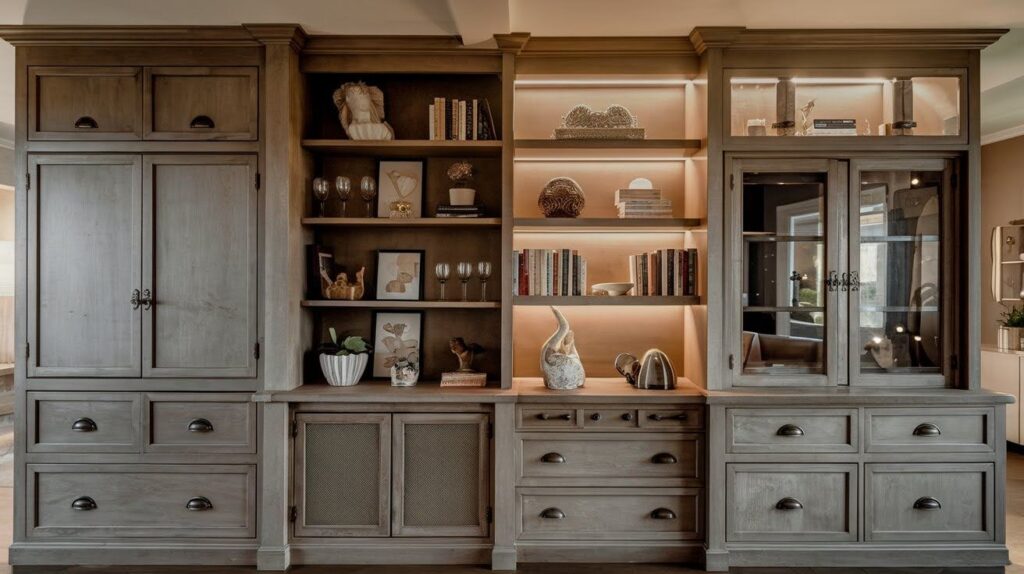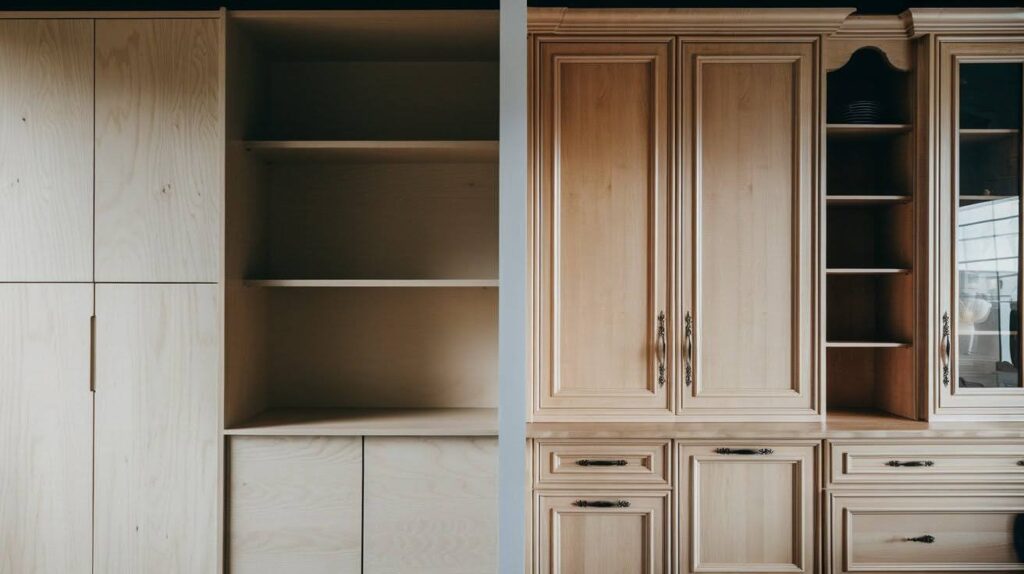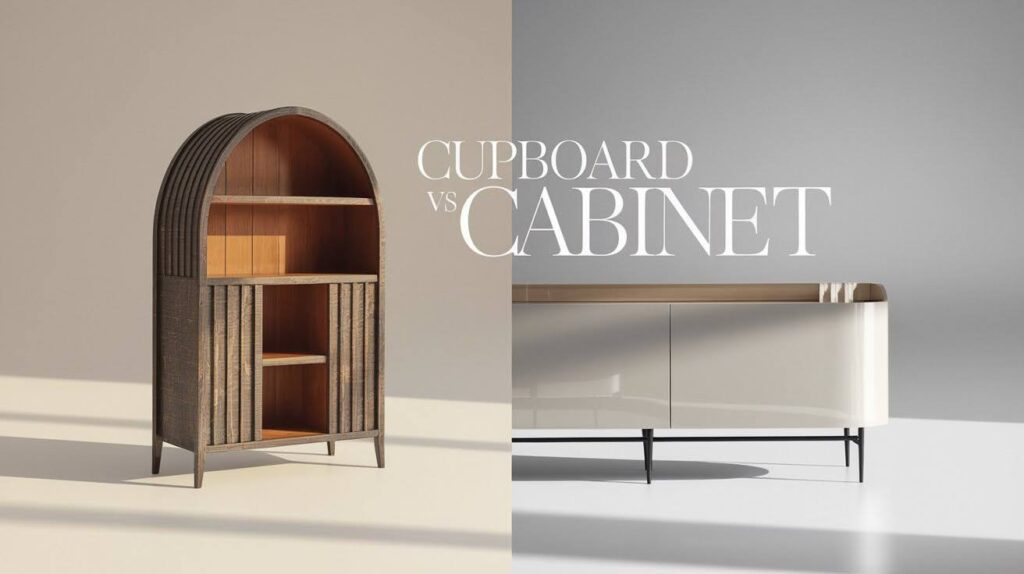Did you go to a furniture shop to wonder about what you may buy?
In daily language, “cupboard” equals “cabinet” frequently. But sometimes it has another meaning, as explained above.
This can matter more than you may think so it can help you to find storage that is right for a kitchen, bedroom, or living room. It also makes talking to interior designers much easier.
In this blog, we’ll break down everything you need to know. We’ll look at how people use them, their designs, materials, and when to choose one over the other.
Cupboard vs Cabinet: Key Differences Comparison Table
Let’s have a quick look at the differences:
| Feature | Cupboard | Cabinet |
| Purpose | Primarily storage | Storage + display |
| Design | Fixed shelves, simple appearance | Adjustable shelves, glass doors, decorative details |
| Materials | Wood, MDF, particleboard, plastic | Hardwood, plywood, metal; higher-quality craftsmanship |
| Locations | Kitchens, bedrooms, bathrooms; often freestanding | Kitchens, bathrooms, living rooms, offices; built-in or wall-mounted |
| Cost | Generally more affordable | Usually more expensive due to materials and craftsmanship |
| Customization | Limited | Highly customizable |
| Functionality | Basic storage | Storage + display, adjustable and multi-functional |
What is a Cupboard?

Cupboards are practical storage units with doors and shelves. They help you organize household items while keeping them hidden from view.
Definition and Purpose
A cupboard is a storage unit that comes with doors and shelves. People originally used it to store dishes, cups, and linens.
The main goal is to keep things organized and out of sight. It’s built for function, not for showing off your items.
Common Uses and Locations
You’ll find cupboards in many rooms of your home. They work great in kitchens for storing food and dishes.
Pantries use them to hold groceries and cooking supplies. Bedrooms need them for clothes and personal items. Even bathrooms have small cupboards for towels and toiletries.
You can get them in two types. Some are freestanding, which means you can move them around. Others are built into the wall and stay in one place.
Materials and Construction
Most cupboards are made from wood, particleboard, or MDF. These materials keep the cost reasonable. Modern versions sometimes use plastic or metal parts. The design is usually simple and straightforward. This makes them practical for everyday use.
Benefits of Cupboards
- Budget-friendly compared to other storage options
- Easy to clean with just a damp cloth
- Simple maintenance that doesn’t require special care
- Flexible placement for freestanding models
- Can be moved to different rooms when needs change
- Perfect for renters or people who like rearranging their space
What is a Cabinet?

Cabinets are versatile storage units that serve multiple purposes. They combine practical storage with the ability to display your favorite items attractively.
Definition and Purpose
A cabinet is a storage unit that offers more options than a basic cupboard. It comes with doors, shelves, and sometimes drawers too.
You can use it to hide everyday items or show off decorative pieces. This dual purpose makes it popular in many homes.
Common Uses and Locations
Cabinets fit well in almost any room. Kitchens use them to store cookware and display fine china. Bathrooms need them for toiletries and cleaning supplies.
Living rooms benefit from cabinets that hold books and show decorative items. Dining rooms use them for dishes and glassware. Offices rely on them for files and supplies.
Most cabinets are built into walls or mounted directly on them. This saves floor space and creates a clean, organized look.
Materials and Construction
Cabinets are typically made from quality materials like hardwood, plywood, or metal. These materials last longer and look better over time.
The designs are often more detailed than cupboards. You’ll find adjustable shelves that move up or down. Many have decorative hardware like handles and knobs that add style.
Benefits of Cabinets
- Combines storage with display options in one unit
- Improves room appearance with decorative finishes
- Features adjustable shelves for flexible organization
- Customizable to match your specific requirements
- Built-in options save valuable floor space
- Durable materials ensure long-lasting use
How to Choose Between a Cupboard and a Cabinet

Picking the right storage option depends on your specific situation. Let’s look at three important factors that will help you decide.
Assess Your Storage Needs
Think about what you want to accomplish. Do you just need a place to hide your items? A cupboard works perfectly for this. Want to show off decorative pieces while storing other things?
A cabinet is your best choice. Some people need both functions in one unit. Understanding your primary goal makes the decision much easier.
Budget Considerations
Money plays a big role in your choice. Cupboards are the more affordable option. They give you solid storage without straining your wallet.
Cabinets cost more because of better materials and detailed craftsmanship. If you’re working with a tight budget, cupboards make sense. But if you can spend more, cabinets offer extra features that justify the price.
Matching Your Home Design
Your home’s style matters too. Cupboards fit well in minimalist spaces. They work great in functional areas where you need simple, clean lines.
Cabinets suit homes with more detailed designs. They add character to living rooms, dining areas, and offices. Think about the room’s overall look. Choose the option that complements what you already have.
Tips for Choosing Between a Cupboard and a Cabinet
Making the right choice requires careful thought. These practical tips will guide you toward the best decision for your home.
- Assess Your Storage Needs: Decide what you really need. Do you want hidden storage, display space, or both? Write down your priorities before shopping.
- Consider Budget and Materials: Cabinets cost more but offer durability and customization. Cupboards are budget-friendly and simple to maintain. Calculate what you can comfortably spend.
- Match Your Home Design: Cupboards work best in minimalist or functional spaces. Cabinets suit rooms where you want more personality and multi-purpose use.
- Placement and Space Optimization: Freestanding cupboards offer flexibility for rearranging. Built-in cabinets maximize vertical space and keep floors clear. Measure your space first.
- Maintenance and Longevity: Clean surfaces weekly and check hinges monthly. Tighten loose screws promptly. Refinish wood every few years to extend the life of your furniture.
Conclusion
The terms cupboard and cabinet are different. Cupboards store things and are often simpler and less expensive than cabinets.
Cabinets have both storage and display functions, and they generally have more elaborate designs and higher prices than cupboards.
Buy what you need and how much you plan on using it daily, bearing in mind your budget, the style of your room, and the spacing you have available to use in it.
The right storage solution makes your home work better for you. Just take your time. Measure twice, buy once.
Today you make a smart informed choice for your future self. Your future self will thank you then.
Frequently Asked Questions
What is the main difference between a cupboard and a cabinet?
A cupboard is primarily used for storage with simple, fixed shelves and basic designs. A cabinet offers both storage and display options with adjustable shelves and more decorative features.
Are cabinets more expensive than cupboards?
Yes, cabinets typically cost more due to higher-quality materials like hardwood and detailed craftsmanship. Cupboards are more affordable and use simpler materials like MDF or particleboard.
Can I use a cupboard in my living room?
You can, but cupboards work better in functional spaces like kitchens, bedrooms, and pantries. Cabinets are more suitable for living rooms because they offer display options and decorative appeal.
Which one is easier to maintain?
Cupboards are easier to maintain because of their simple design and basic materials. Both need regular cleaning and occasional hardware checks, but cupboards require less specialized care.
Should I choose a freestanding or built-in option?
Freestanding cupboards offer flexibility and can be moved to different rooms as needed. Built-in cabinets save floor space and create a permanent, streamlined look in your home.

